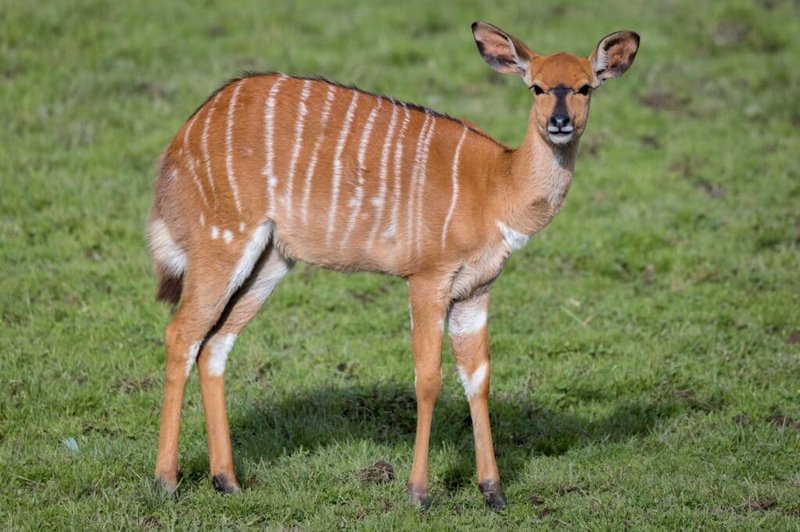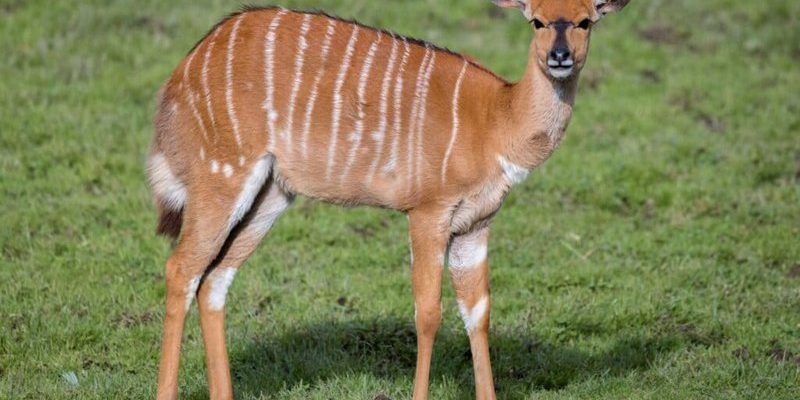
Imagine you’re walking through a lush savanna, where the golden grass sways gently in the breeze. Spotting a Nyala gracefully navigating its environment might make you curious about which other animals it’s sharing space with. From the Impala to the Kudu, several species not only look somewhat like the Nyala but also exhibit unique traits and behaviors. Understanding these differences could make your wildlife encounters even more enjoyable.
So, whether you’re planning a safari or just curious about these fascinating creatures, let’s explore ten animals that resemble the Nyala and figure out how to tell them apart!
1. Greater Kudu
Ah, the Greater Kudu—another stunning antelope sporting those impressive spiral horns! The Kudu is larger than the Nyala, with males reaching heights of up to 4.5 feet at the shoulder. Here’s the thing: while both have similar coat colors, the Kudu has more pronounced white stripes on its body, which help it blend into the bush.
Another way to tell them apart? Kudus have long, narrow faces, accentuated by their large ears that can rotate to pick up the faintest sounds. If you see a herd of Kudu, you’ll notice they often stick together, unlike the more solitary Nyala. Their behavior can provide clues too—Kudus tend to be more skittish and will often leap away if they sense danger.
Ultimately, if you spot one with impressive horns standing tall and blending into the trees, you’ve likely encountered the Greater Kudu instead of the Nyala!
2. Impala
Next up is the Impala, a familiar face in African savannas. These gazelle-like antelopes are often seen in large groups—and that’s a big hint! Unlike the Nyala, which is more solitary, Impalas thrive in herds.
Physically, they’re a bit smaller than Nyala. Male Impalas have sleek, curved horns that grow in a much different style than the spiral horns of the Nyala. Additionally, Impalas showcase distinct black markings on their faces and legs. To spot an Impala, look for its lively bounding jump, which is a characteristic that sets them apart from the more cautious Nyala.
The vibrant and social nature of Impalas can make them a joy to observe, especially when they’re interacting with one another!
3. Bushbuck
The Bushbuck is another close cousin of the Nyala, often found in similar habitats. These antelopes have a stocky build and a warm brown coat, making them blend in quite well with the bush. But here’s the kicker: Bushbucks are generally smaller than Nyala, with females lacking the distinctive spiral horns that males sport.
You might notice that Bushbucks also have white markings on their face and legs—similar to the Nyala, but the patterns differ. Bushbucks often prefer thickets and denser cover, which makes encounters with them a bit more challenging.
If you see a shy animal peeking from behind dense foliage, there’s a good chance it’s a Bushbuck instead of a Nyala!
4. Sitatunga
Now let’s talk about the Sitatunga, an antelope that truly embraces an aquatic lifestyle. Unlike the Nyala, which prefers dryer terrains, Sitatungas are often found near swamps and marshlands, thanks to their unique adaptations for swimming.
One of the standout features of the Sitatunga is its elongated hooves, which help it navigate through muddy waters. Their coats are also much hairier and often lighter, giving them a different appearance from the sleek Nyala. Plus, male Sitatungas often have a more shaggy look, which is a notable distinction.
So, if you’re near water and see an antelope effortlessly wading through, it’s likely a Sitatunga and not a Nyala!
5. Waterbuck
Waterbucks are another fascinating animal similar to the Nyala, especially in their love for watery habitats. However, Waterbucks are larger and have a distinct, shaggy coat that can look a bit scruffy compared to the Nyala’s smoother appearance. Their most distinguishing feature is the white circle on their rear, which is something you won’t find on Nyala.
Males sport impressive curved horns as well, but they tend to be more robust. When spotting them, pay attention to their group behavior; Waterbucks are social creatures, often found in groups—unlike the more solitary Nyala.
So if you catch sight of a larger antelope lounging by a water source with a noticeable ring on its behind, that’s the Waterbuck!
6. Bongo
The Bongo is like a colorful cousin of the Nyala, known for its striking reddish-brown fur and bold white stripes. Just look at those markings! While they share a similar habitat, the Bongo is usually larger and has more vivid coloration, particularly in males.
Additionally, the Bongo has long, slender horns that twist, which are quite different from the spiraled horns of the Nyala. They also tend to be more elusive and secretive, often retreating deeper into forests when threatened.
So, if you happen upon a vibrant antelope with a flair for hide-and-seek in the forest, it’s probably a Bongo and not a Nyala!
7. Roan Antelope
Roan Antelopes are notable for their impressive build and striking appearance, sporting heavy horns that can curve back like a crown. Comparing them to the Nyala, Roans tend to be larger and have a darker, more robust body. You’ll notice their short, sleek coat is quite different from the shaggy Nyala fur.
Roan Antelopes also have a distinctive face, with a more pronounced muzzle and a tuft of hair on the forehead. They often spend their time in open savannah areas, gathering in small groups. Unlike the Nyala, which prefers thicker brush, the Roan is more visible against the landscape.
When you spot an antelope standing proud with a regal stance, keep an eye out—it just might be a Roan!
8. Sable Antelope
Sable Antelopes are known for their striking features, especially the males with their long, curved horns. They share the Nyala’s habitat but are generally larger and have a more pronounced build. The Sable is often darker, showcasing a rich black coat that really stands out, especially against the green backdrop of their surroundings.
Notably, Sables are also known for their aggressive nature, making them quite different from the Nyala’s more cautious demeanor. Their facial markings are usually more pronounced with a prominent white stripe running down the face, distinguishing them further.
If you encounter a bold and striking antelope with impressive horns, you’ll know you’re looking at a Sable!
9. Grant’s Gazelle
Grant’s Gazelle is another close relative often found in similar habitats as the Nyala, yet their appearance varies significantly. They have a more streamlined body structure, with long legs designed for speed. Unlike the Nyala, which has that lovely shaggy coat, Grant’s Gazelles sport short, smooth fur, with males having long, slender horns that curve back.
You’ll find Grant’s Gazelles are usually seen in larger herds, making them more social than the Nyala. Their energetic nature and graceful leaping are truly sights to behold.
So if you see a group of sleek, fast-moving antelopes, it’s likely they’re Grant’s Gazelles, not Nyala!
10. dik-dik
Last but certainly not least is the dik-dik, a tiny antelope that could easily be mistaken for a sweet little puppy. Although much smaller than the Nyala, dik-diks share some habitat preferences, but they’re usually found in pairs rather than large groups.
Dik-diks are known for their large eyes and small stature, which makes them quite adorable. They have a distinctive elongated nose and come in shades of brown that allow them to blend in with the scrubland. While Nyala can be both shy and solitary, dik-diks are a bit more social as they pair up for protection.
If you spot a miniature antelope with those big, wide eyes peeking through the brush, there’s a great chance it’s a dik-dik!
In conclusion, the world of antelopes is varied and rich, with many species that share similarities with the Nyala. By paying attention to key features and behaviors, you can confidently identify these fascinating animals in their natural habitat. Next time you find yourself out in nature, take a moment to appreciate the unique characteristics of these hoofed mammals and the intricate roles they play in their ecosystems. Happy wildlife watching!

